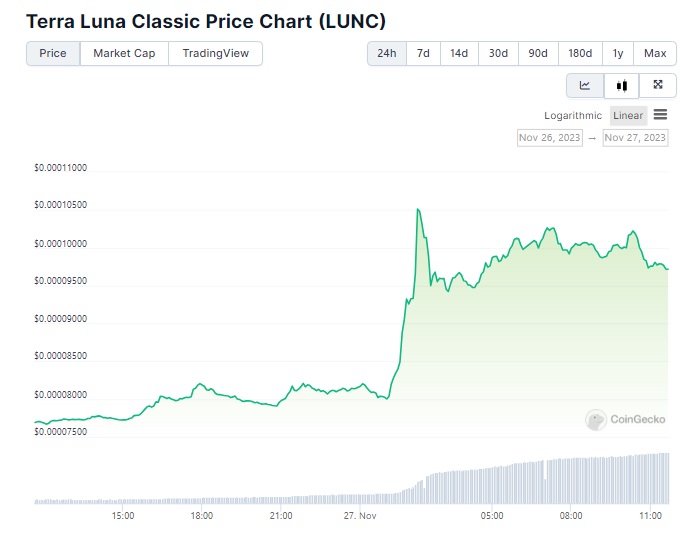Why is the Terra Luna Classic price pumping? Here is a timeline on the whole saga so you can quickly catch up on the story.

In 2018, the Terra ecosystem, run by Terraform Labs, was designed to be a new kind of money that was stable, fast, and cheap to use. It used two types of tokens: LUNA and UST.
LUNA was the main token that powered the whole system. People who owned LUNA could stake it, which meant they locked it up in exchange for rewards. The rewards came from the fees that people paid when they used the system. LUNA was also designed to keep the price of UST stable.
UST was designed as a stablecoin, which meant it was supposed to have the same value as one US dollar. People could use UST to buy things online, save money, or invest in other projects. UST was not backed by real dollars, but by an algorithm.
How the Algorithm Worked
The algorithm worked like this: if UST was worth more than one dollar, there was more demand than supply. So the system would create more UST and sell it for LUNA, increasing the supply of UST and decreasing the supply of LUNA. This would lower the price of UST and raise the price of LUNA, until they reached equilibrium.
If UST was worth less than one dollar, it meant there was more supply than demand. So the system would buy back UST with LUNA, decreasing the supply of UST and increasing the supply of LUNA. This would raise the price of UST and lower the price of LUNA, until they reached equilibrium.
The terra luna ecosystem was very popular and considered innovative, until it collapsed in May 2022.
A mysterious attacker exploited a flaw in the algorithm and caused UST and LUNA to lose most of their value.
The system was relaunched as LUNA 2.0, with a new algorithm and more funding, but some people still use the original chain, which is now called Terra Classic (LUNC). Here is the timeline of events.
Timeline to Terra Luna Classic price jump
2018
Do Kwon (now in prison) and Daniel Shin get together to launch the Terra network. They also aim to grow Chai. It is an e-commerce payments app, aiming to use a stablecoin alongside fiat currencies for transactions in the app.
2019
Terraform Labs launches its first cryptocurrency token, LUNA, which serves as the primary backing asset for Terra, also used as a governance token for users to vote on Terra community proposals.
2020
Terra introduces several stablecoins, named according to the currencies to which they were pegged — for example, TerraUSD (UST) was pegged to the U.S. dollar.
UST stablecoins were not backed by U.S. dollars; instead, they were designed to maintain their peg through a complex algorithm.
2021
Terra became one of the most popular and valuable crypto projects, attracting more than US$200 million from investment firms such as Arrington Capital, Coinbase Ventures, Galaxy Digital and Lightspeed Venture Partners.
Terra also builds a fully-functional ecosystem of decentralised applications (or DApps), such as Anchor, Mirror, and Pylon, which utilise the stable-coin infrastructure of Terra.
May 2022
The Terra blockchain is temporarily halted after the collapse of the stablecoin TerraUSD (UST) and Luna, in the event that wiped out almost $45 billion in market capitalisation within a week.
UST’s value plunges from US$1 to US$0.35 (AU$1.52 to AU$0.53). Luna’s value falls from US$80 (AU$121.50) to a few cents. Some analysts suspect that an “evil genius” may have caused the crash by exploiting a flaw in the algorithmic model of Terra.
June 2022
Terraform Labs announces the relaunch of the Terra chain as LUNA 2.0, with a new algorithm and a $15 million capital boost to restore confidence in the project.
The original chain, which is still operating, is renamed as Terra Classic (LUNC), and some investors bet on its revival.
November 2023: Terra Luna Classic moves
Terra Luna Classic (LUNC) holders increase 500 percent in a month, as the token reaches $10, restoring its former glory.
LUNA 2.0 also gains momentum, with a stable UST peg and a growing ecosystem of DApps.
Terra is once again one of the leading crypto projects, with a combined market capitalisation of over $100 billion.
Terra Luna Classic: Current Events
There are three main reasons why Terra Luna is now rising in price.
The project recently launched a big upgrade called Columbus-5, which changed how LUNA and UST work. Now, every time someone creates UST, some LUNA is destroyed. This makes LUNA more scarce and valuable.
The project also joined the Cosmos network, which is a group of different blockchains that can talk to each other. This means that Terra Luna can reach more users and projects that use the Cosmos network. This increases the demand for UST and LUNA.
The project has many applications that use UST and LUNA for different purposes, such as paying, saving, and investing. These applications are very popular and attract more people to use Terra Luna. This also increases the demand for UST and LUNA.
While this is an astounding turnaround, given the history of the Terra Luna ecosystem, the long-term viability of Terra 2.0 remains uncertain and still faces challenges. Remember kids, do your research!





